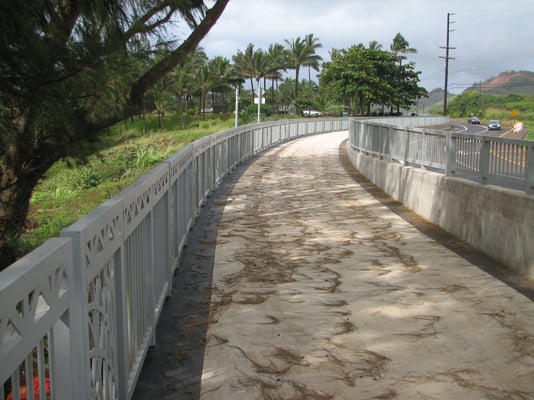Architectural railings are an integral part of building design, serving both functional and...
Exploring the World of Architectural Railings: Types, Styles, and Applications
Architectural railings are an integral part of building design, serving both functional and aesthetic purposes. These essential elements have evolved over time to meet various design preferences and safety requirements. In this guide, we will explore architectural railings, their components, and some materials used in architectural railing construction. We will also look at three railing styles at a high level and cover three of the most common applications where they come into play.
 PHOTO 1: Architectural fiberglass reinforced plastic (FRP) railing used in the Wailua Cane Haul Bridge in Kauai, HI PHOTO 1: Architectural fiberglass reinforced plastic (FRP) railing used in the Wailua Cane Haul Bridge in Kauai, HI |
Architectural Railing Components and Materials
A comprehensive railing system consists of five components, each serving a distinct purpose. Please note that not every application will include every component:
- Balusters: Vertical posts or spindles, evenly spaced along the length of the railing to provide support and safeguard against people or objects falling through the space under the top. While they are the primary structural elements of a railing, they can also be decorative.
- Balustrade: Also known as the banister when part of a staircase, this is the term for the collection of balusters.
- Base Rail: Positioned at the bottom of the balusters, the base rail complements the handrail and helps maintain the spacing and alignment of the balusters.
- Handrail: Runs horizontally along the top of the balusters, offering additional structure for the railing system and a secure surface to hold onto while ascending or descending stairs or walking along elevated areas. Note: Railings may have both a guardrail (for safety) and a handrail (for guidance). See this blog about guardrails vs. handrails to learn more.
- Newel Post: Typically found at the beginning and end of a railing or at key turning points, newel posts provide stability and serve as anchor points for the handrail.
- Fillet or Shoe Rail: Horizontal components positioned between the balusters and the base rail, adding structural integrity and design flair.
When it comes to selecting materials for a given railing system, there are four common choices, each presenting advantages and disadvantages that reflect design preferences and functional requirements:
- Wood has a warm look and feel, and offers nearly endless customization options for both traditional and contemporary designs. The downside is that wood railings demand regular maintenance to prevent deterioration, rot, and termite damage.
- Metal (wrought iron, stainless steel, and aluminum) are durable and customizable, making them popular for intricate and modern designs. They have more resistance than wood to environmental elements as long as they are adequately coated or maintained. Metal railing systems do have the disadvantage of being heavy. The material may also require equipment to lift into place and specialized skills such as welding for installation.
- Glass railings offer a modern, elegant appearance, creating a sense of openness and spaciousness. While they may be resistant to weather, maintaining a pristine appearance requires careful frequent cleaning. Glass may also be less impact-resistant than other materials.
- Composite Materials (such as Fiberglass Reinforced Plastic - FRP) are often used in modern and minimalist railing designs and are celebrated as a low maintenance material with impressive durability against environmental factors. FRP gives designers a versatile material choice that comes in many colors. This material is lightweight, easy to cut to size on site, and requires no special equipment for installation.
Each material choice for architectural railings offers its own set of benefits and drawbacks, allowing architects and designers to select the most suitable option based on the specific project requirements, desired aesthetics, and long-term maintenance considerations.
 PHOTO 2: Modern style architectural railing used in a residential setting (not FRP) PHOTO 2: Modern style architectural railing used in a residential setting (not FRP) |
Architectural Railing Styles and Designs
- Modern and Minimalist Railings
Characterized by clean lines, geometric shapes, and the use of materials like FRP. They are not only sleek but also easy to maintain, making them a popular choice for contemporary designs. - Classic and Ornate Railings
Feature intricate details and ornamental elements influenced by historical designs. These railings add a touch of elegance and grandeur to traditional settings. - Contemporary and Eclectic Railings
Embrace creative combinations of materials, textures, and forms. These designs are perfect for those looking to create a unique and eclectic architectural style.
Architectural Railings Applications
Aside from residential examples, you will also find architectural railings enhancing utility and visual appeal in both commercial and public spaces. Railings in commercial buildings not only ensure safety but also contribute to the building's aesthetics. They are commonly used in offices, hotels, and retail spaces.
In public space applications, architectural railings can help promote efficient pedestrian flow. In parks and plazas, railing systems might delineate pathways, reducing the risk of accidental falls and guiding visitors through the space. Moreover, in transportation hubs like train stations and airports, railings serve as vital safety barriers along platforms and escalators while contributing to the aesthetics of the environment.
Finally, in specialized environments such as manufacturing facilities and utility plants, safety codes may require railings designed with specific safety and functionality considerations in mind. These guard railings are critical for worker safety and compliance with industry regulations.
By exploring the various materials, styles, and applications of architectural railings, we can appreciate their significance in both form and function. For more on how Fibergrate is used in architectural projects, contact your local sales rep and get expert guidance.


